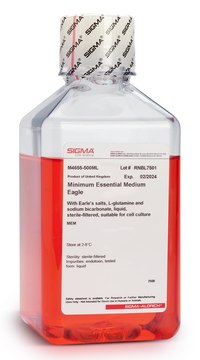B1522
Basal Medium Eagle
With Earle′s salts and sodium bicarbonate, without ʟ-glutamine, liquid, sterile-filtered, suitable for cell culture
Produzione farmaceutica
Sinonimo/i:
BME
About This Item
Prodotti consigliati
Nome del prodotto
Basal Medium Eagle, With Earle′s salts and sodium bicarbonate, without L-glutamine, liquid, sterile-filtered, suitable for cell culture
Livello qualitativo
Sterilità
sterile-filtered
Stato
liquid
tecniche
cell culture | mammalian: suitable
Impurezze
endotoxin, tested
Componenti
L-glutamine: no
NaHCO3: yes
Earle’s salts (5% CO2): yes
Condizioni di spedizione
ambient
Temperatura di conservazione
2-8°C
Cerchi prodotti simili? Visita Guida al confronto tra prodotti
Descrizione generale
Applicazioni
- as a component in the culture medium for cochlear organotypic cultures and salicylate treatment
- to maintain cerebellar granule neurons (CGNs) to determine if there is a system that regulates the distribution and/or group dynamics of axonal mitochondria
- in the preparation of cortical slices, serum-free medium, and slice culture medium for slice overlay assay to study the influence of extracellular signals on neuronal development
Ricostituzione
Comunemente ordinati con questo prodotto
Supplemento
Codice della classe di stoccaggio
12 - Non Combustible Liquids
Classe di pericolosità dell'acqua (WGK)
WGK 1
Punto d’infiammabilità (°F)
Not applicable
Punto d’infiammabilità (°C)
Not applicable
Scegli una delle versioni più recenti:
Possiedi già questo prodotto?
I documenti relativi ai prodotti acquistati recentemente sono disponibili nell’Archivio dei documenti.
I clienti hanno visto anche
Articoli
Cell culture protocol for passaging and splitting suspension cell lines
Il team dei nostri ricercatori vanta grande esperienza in tutte le aree della ricerca quali Life Science, scienza dei materiali, sintesi chimica, cromatografia, discipline analitiche, ecc..
Contatta l'Assistenza Tecnica.









